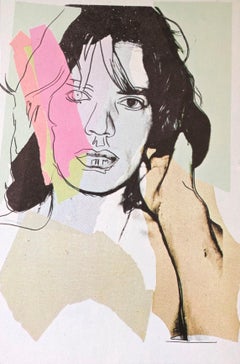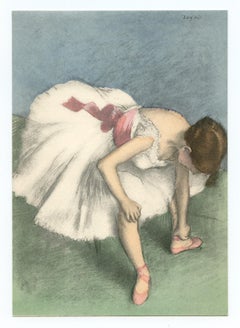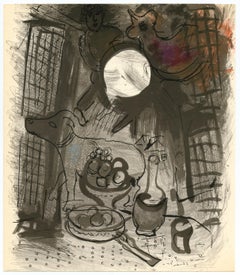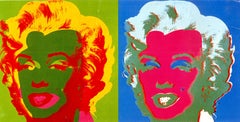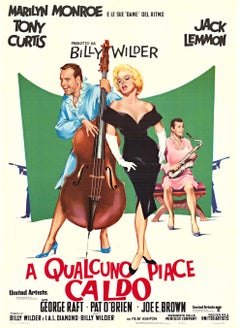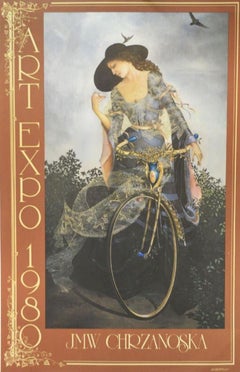Vertical Portrait Prints
to
1,640
2,846
1,170
1,302
749
552
Overall Width
to
Overall Height
to
1,817
1,392
482
290
272
136
128
123
112
89
85
10
7
3
172
84
80
80
78
258
1,196
3,574
1,590
49
119
156
132
220
202
420
688
469
219
213
6,619
1,583
498
5,030
2,729
2,461
2,035
1,475
1,289
964
823
712
594
547
384
344
327
220
171
168
146
141
132
2,580
1,419
1,171
644
440
992
2,655
3,594
2,172
Orientation: Vertical
Mick Jagger V - Andy Warhol, Announcement card, Rolling Stones, Musician, Pop
Located in Knowle Lane, Cranleigh
Mick Jagger V - After Andy Warhol. The light green background contrasts with the abstract pink slashes on the image of this lithographic print. Mick Jagger is an iconic rock legend who was the frontman and one of the founders who sang lead in the British Rock and Roll Band, The Rolling Stones...
Category
1970s Pop Art Portrait Prints
Materials
Lithograph
pochoir
Located in Henderson, NV
Medium: pochoir (after the pastel). A soft and delicate impression, printed in Paris in 1948 and published in an edition of 1200 by Braun et Cie. Size: 6 1/2 x 4 1/2 inches (164 x 11...
Category
1940s Impressionist Portrait Prints
Materials
Lithograph, Stencil
"Nature morte brune" original lithograph
By Marc Chagall
Located in Henderson, NV
Medium: original lithograph. Catalogue reference: Mourlot 205. This charming composition is one of the original lithographs Chagall contributed for a volume by Jacques Lassaigne, pub...
Category
1950s Portrait Prints
Materials
Lithograph
Exclusive Invitation Card to Andy Warhol Memorial Lunch from Estate of Tim Hunt
By Andy Warhol
Located in New York, NY
SUPER RARE!
Invitation Card to private Andy Warhol Memorial Lunch, from the Estate of Tim Hunt, 1987
Offset lithograph card
6 1/2 × 3 3/5 inches
Unframed
This exclusive invitation to the private memorial lunch for Andy Warhol is an historic collectors item. Few people in the world own this card other than those who were invited to the event and/or their heirs, though it has occasionally appeared at public auction now that another generation has passed. This offset lithograph invitation card to Andy Warhol's Memorial Lunch at the Diamond Horseshoe in the Paramount Hotel bears an image of Andy Warhol's iconic 1967 Marilyn on one side, and on the other side is an announcement that reads as follows:
ANDY WARHOL
A Memorial Lunch
Wednesday, April 1, 1987
The Diamond Horseshoe
235 West 46th Street
New York City
Special thanks to:
Carillon Importers
Caffe Condotti
Glorious Food
All leftover food and flowers will be donated to the homeless program at Church of the Heavenly Rest.
Marilyn - Andy Warhol 1967
The provenance of this card is impressive as it comes from the estate of Warhol Foundation curator and sales agent Tim Hunt, who was married to bestselling author Tama Janowitz, author of "Slaves of New York". Tama would describe how she met Tim Hunt as follows: "Andy Warhol died in 1987. In the long hot summer after, I bought a tiny basement apartment on West 70th Street over by West End Ave. That’s when I met Tim Hunt. A model for Werther’s Caramel and Ralph Lauren who’d gone to Oxford and had a brother who was a famous race car driver, he’d been with Christie’s a few years and had come over from England to work on the Warhol estate. He would later become my husband. Andy would have loved Tim. But the two had never met..."
The event in this invitation is the more exclusive Memorial Lunch on April 1st 1987, held prior to Warhol's Memorial Mass at St. John the Divine, later that evening, the latter of which was attended by thousands of people. The press referred to this earlier event as a "Special Memorial Lunch Party" - using the vernacular of the day, as everything in the mid to late 1980s seemed like a party - until it was not. Interestingly, no start time, or even time range, is mentioned on this invitation - something that is rarely if ever missing from such an item; further evidence that it wasn't enough just to get this card; one had to already be in the know to be able to attend. Either that, or the lunch party was going on all day - so invitees could show up whenever they wanted. Or, alternatively, it was simply an accidental omission with no hidden message. And another side note: one of the sponsors of this Memorial luncheon, Carillon Importers, is the holding company or importer for Absolut Vodka, which commissioned Andy Warhol to create a series of advertising ads that would comprise one of the most successful, award-winning advertising campaigns of the era - and the most successful of the company's history. Who attended this event? Probably everybody who was anybody in the nexis of art, celebrity, high fashion and big business. Getty images features photographs by celebrity paparazzo Ron Galella of some of Warhol pals entering or leaving the Diamond Horseshoe for this exclusive event including Dianne Brill...
Category
1980s Pop Art Figurative Prints
Materials
Lithograph, Offset
Some Like it Hot Qualcuno Piace Caldo original vintage Italian movie poster
Located in Spokane, WA
Original Some Like it Hot vintage movie poster. A Qualcuno Piace Caldo". Linen-backed Italian size 39" x 55", in Good condition. Ready to frame.
The images are of the exact poster you will receive. These Italian vintage movie...
Category
Late 20th Century American Modern Portrait Prints
Materials
Offset
$1,160 Sale Price
20% Off
Poster-Art Expo 1980. Cosmic Pilgrim Productions
Located in Chesterfield, MI
J.M.W. CHRZANOSKA (American, b. 1948)
Art Expo 1980
Poster
39.75 x 25.75 in. Unframed
Plate signed
Publishing Information: Cosmic Pilgrim Productions
Good/Fair Condition-discolorat...
Category
1980s Portrait Prints
Materials
Lithograph
$160 Sale Price
20% Off
original etching
Located in Henderson, NV
Medium: original etching. Printed in 1984 on Cartiere Magnani paper at the atelier of Bruce Chandler in an edition of 1500. This work was executed by Leonard Baskin to illustrate the...
Category
1980s Expressionist Portrait Prints
Materials
Etching
Portrait of Albert Schweitzer.
Located in Storrs, CT
Portrait of Albert Schweitzer. Etching. 11 3/4 x 9 3/4 (sheet 16 1/4 x 14). Illustrated: Beall, American Prints in the Library of Congress, page 205....
Category
1950s American Modern Interior Prints
Materials
Etching, Drypoint
$750 Sale Price
50% Off
Head of a Gaul, British Museum Roman Classical sculpture photogravure
Located in Melbourne, Victoria
'Head of a Gaul'
Photogravure from a collection of photogravures depicting Greek and Roman marbles and bronzes in the British museum. Plate number above top right corner of the imag...
Category
1910s Other Art Style Portrait Prints
Materials
Photogravure
Weiße Blume
Located in Kansas City, MO
Giclee on handmade cotton paper
Year: 2016
Size: 19.68 x 24.01 inches (50 x 61cm)
Edition: 75, not individually numbered
Signed by hand
COA provided
Paul Indrek Kostabi (also known...
Category
2010s Contemporary Portrait Prints
Materials
Handmade Paper, Giclée
$355 Sale Price
49% Off
Original 1966 poster Museo Picasso Palacio Aguilar Barcelona Spain
Located in Miami, FL
Pablo Ruiz Picasso (Spain, 1881-1973)
'Museo Picasso. Palacio Aguilar.', 1966
Four-color offset printing on paper
30 x 21.5 in. (76 x 54.5 cm.)
Unframed
Ref: PIC2001-P007
Conservatio...
Category
1960s Expressionist Figurative Prints
Materials
Offset
Vintage Hockney Tate Poster, Celia in Black Dress with white flowers and rainbow
Located in New York, NY
The poster features David Hockney's 1972 drawing Celia in a Black Dress. Viewed through elegantly drooping tulip stems, Celia Birtwell stares dreamily ahead. With one hand paused in ...
Category
1980s Realist Portrait Prints
Materials
Lithograph
Valerio Adami Italian Artist 1976 Original Poster lithograph Galerie Maeght
Located in Miami, FL
"Valerio Adami (Italy, 1935)
'Moments musicaux de six a huit', 1976
Original poster from 1976
lithograph on paper
26 x 18.2 in. (66 x 46 cm.)
Unframed
Ref: ADA100-202
Valerio Adami
...
Category
1970s Abstract Figurative Prints
Materials
Lithograph
Tete De Femme, Modern Lithograph after Pablo Picasso
Located in Long Island City, NY
Pablo Picasso's mastery of perspective and integration of geometric planes into his portraits is evident in this portrait of a woman wearing a matching orange hat and blouse. Returni...
Category
Late 20th Century Cubist Figurative Prints
Materials
Lithograph
Bad Reputation, Black - Shepard Fairey Obey Contemporary Screen Print Urban Art
Located in Draper, UT
Bad Reputation (Black) on Speckle Tone Paper. 18 x 24 inches. Signed by Shepard Fairey. Numbered edition of 83/350.
My Obey “Bad Reputation” print is inspired by music graphics, especially punk and new wave album sleeves, t-shirts, and flyers. I love the Xerox machine with spot color approach to a lot of those graphics that married the rough and crude side of financial and artistic limitations with an intuitive and clever ability to craft subversive, eye-catching images. Some of the edges of this imagery and text are intentionally rough and imperfect… if slick and clean are your bag, you might want to skip this one baby! See if you can spot the references to musicians like the New York Dolls...
Category
2010s Street Art Prints and Multiples
Materials
Screen
Yoshitomo Nara - Dead Of Night
Located in London, GB
Yoshitomo Nara
Dead Of Night
Offset lithograph on paper
Sheet size: 51.5 x 36.4 cm
Stamped with title, artist's name, copyright and year
published by N's Yard, Japan
Category
2010s Contemporary Portrait Prints
Materials
Offset
Marquis de Marigny: An 18th C. Wille Engraved Portrait after a Tocque Painting
By Louis Tocqué
Located in Alamo, CA
This is a mid 18th century engraved portrait of Abel François Poisson de Vandières, Marquis de Marigny by Jean Georges Wille after a painting by Louis Tocque...
Category
Mid-18th Century Portrait Prints
Materials
Engraving
$2,060 Sale Price
20% Off
Portrait Head
By Lucian Freud
Located in New York, NY
Lucian Freud
Portrait Head
2001
Etching on Somerset Textured White paper
28 1/2 x 22 1/2 inches; 72 x 57 cm
Edition of 46
Initialed and numbered in graphite (lower recto)
Frame available upon request
Published by Matthew Marks Gallery...
Category
Early 2000s Contemporary Portrait Prints
Materials
Etching
The Wrath of Elihu: 'I Am Young, And Ye Are Very Old, Wherefore I Was Afraid.'
Located in Storrs, CT
The Wrath of Elihu. 'I Am Young, And Ye Are Very Old, Wherefore I Was Afraid'. 1823-25. Engraving. .Binyon catalog 117 state ii, Bindman catalog 632. Image 7 7/8 x 5 15/16; plate 8 ...
Category
Early 19th Century Romantic Figurative Prints
Materials
Engraving
Liz Taylor Cleopatra (black)
By Zane Fix
Located in East Hampton, NY
These are limited edition archival prints
They come in a variety of colors. Please Inquire
Unframed.
World-renowned guru of Jap Pop Art - Zane Fix, is an American artist, born in B...
Category
2010s Portrait Prints
Materials
Archival Pigment
"Johnny Cash Mugshot" Print 39 x 36 inch Ed. of 75 by Gerard Marti
By Gerard Marti
Located in Culver City, CA
"Johnny Cash Mugshot" Print on canvas 39 x 36 inch Ed. of 75 by Gerard Marti
Digital print on fine art paper.
Ships rolled in a tube.
Signed and numbered by the artist.
Mugshot...
Category
21st Century and Contemporary Pop Art Portrait Prints
Materials
Canvas, Digital
LE PROPHETE (MOURLOT 713)
By Marc Chagall
Located in Aventura, FL
Lithograph in colors on Arches paper. Hand signed and numbered by Marc Chagall. Mourlot 713. Edition 41/50. Image size 27.25 x 21 inches. Sheet size 32 x 24.25 inches. Frame ...
Category
1970s Surrealist Figurative Prints
Materials
Lithograph, Paper
$19,200 Sale Price
20% Off
Salvador Dali - Flung out like - Original Signed Engraving
Located in Collonge Bellerive, Geneve, CH
Salvador Dali - Flung out like a Fag-end by the Big- - Original Signed Engraving
Handsigned in pencil and Numbered
Edition: F195/195
- Printer: Atelier Rigal.
- Paper: Rives vellum ...
Category
1970s Surrealist Figurative Prints
Materials
Etching
Femme au Chapeau, Cubist Lithograph after Pablo Picasso
Located in Long Island City, NY
A lithograph from the Marina Picasso Estate Collection after the Pablo Picasso painting "Femme au Chapeau". The original painting was completed in 1961. In the 1970's after Picasso'...
Category
1980s Cubist Portrait Prints
Materials
Lithograph
1960s "Antique" Woodcut Portrait NY Artist Myril Adler
Located in Arp, TX
Myril Adler
"Antique" portrait
c.1960s
Woodcut on tissue affixed to orange paper
3.5"x5.5" site unframed
Signed and titled in ink
Myril Adler, was born on...
Category
1960s Abstract Portrait Prints
Materials
Paper, Ink, Woodcut
Rising I, lithograph by Trevor Southey
Located in Palm Springs, CA
Male nude lithograph by Trevor Southey. Charcoal gray. There was also an edition done in terra cotta.
Trevor Southey was born in Rhodesia, Africa (now Zimbabwe) in 1940. His African...
Category
1980s Contemporary Nude Prints
Materials
Lithograph
$700 Sale Price
22% Off
Halo Freedom - Grateful Dead & more. original concert poster
Located in Spokane, WA
Halo Freedom - Rick Griffin original 1966 poster.
Benefit for Haight Ashbury Legal Organization, an On-scene summer long guarantee of your Freedom. Indian Agent Excellent / mint condition. The image is to resemble a distressed old photograph, but this poster is meint as stated. No damage, no pinholes, no bent corners… just very fine indeed!
PERFORMERS: Grateful Dead, Jefferson Airplane, Big Brother and the Holding Company, Quicksilver Messenger Service, Charlatans
Haight Ashbury Legal Organization. Winterland Concert HALO (Haight Ashbury Legal Organization)
Original First Printing, not a reproduction. Concert featuring: The Jefferson Airplane, Janis Joplin with Big Brother & The Holding Company, Quicksilver Messenger Service, The Charlatans...
Category
1960s Pop Art Portrait Prints
Materials
Offset
$238 Sale Price
20% Off
Original Thessaloniki Greece vintage travel poster Church of St. George Mosaic
Located in Spokane, WA
Original travel poster: THESSALONIKI GREECE. Church of St. George (Mosaic, 5th Century). Linen backed in excellent condition; ready to frame. Signed with monogram lower left c...
Category
1950s Byzantine Portrait Prints
Materials
Lithograph
"La seance de trois heures" pochoir
Located in Henderson, NV
Medium: pochoir (after the watercolor). Printed in 1924 and published in Paris by Albert Morance for "L'Art d'Aujourd'hui", and now very scarce. The publisher's provenance inscriptio...
Category
1920s Portrait Prints
Materials
Lithograph, Stencil
The Hon. Stephen Coleridge, Vanity Fair caricature chromolithograph print, 1910
Located in Melbourne, Victoria
'Anti-Vivisection'
Vanity Fair portrait of The Hon. Stephen Coleridge
Hentschel-Colourtype. 1910.
Stephen William Buchanan Coleridge (1854-1936) was an English author, barrister,...
Category
Early 20th Century Victorian Figurative Prints
Materials
Lithograph
original woodcut for Pierre a feu Les miroirs profonds
Located in Henderson, NV
Medium: original woodcut. Printed in 1947 in an edition of 950 on Rives wove paper for "Pierre a feu / Les miroirs profonds" and published in Paris by Maeght. Image size: 8 1/4 x 6 1...
Category
1940s Portrait Prints
Materials
Woodcut
La Capeline de Paille d'Italie (The Italian Straw Hat).
Located in Storrs, CT
La Capeline de Paille d'Italie (The Italian Straw Hat). 1923. Lithograph. Duthuit 430. 17 3/4 x 15 3/4 (sheet 23 1/8 x 17 7/8). Trial proof, apart fr...
Category
Early 20th Century Modern Portrait Prints
Materials
Lithograph
$48,000 Sale Price
20% Off
"La branche de lilas" pochoir
Located in Henderson, NV
Medium: pochoir (after the watercolor). Printed in 1924 and published in Paris by Albert Morance for "L'Art d'Aujourd'hui", and now very scarce. The publisher's provenance inscriptio...
Category
1920s Portrait Prints
Materials
Stencil, Lithograph
Cabeza en Ocre, Surrealist Etching by Rufino Tamayo
Located in Long Island City, NY
A Surrealist etching by Mexican artist Rufino Tamayo of a simple yellow figure with a bird beak against a white background, staring at the viewer with piercing white eyes. This piece...
Category
1980s Portrait Prints
Materials
Etching
LE CHEVALET AUX FLEURS (MOURLOT 838)
By Marc Chagall
Located in Aventura, FL
Hand signed and numbered by the artist. Lithograph in colors on wove paper. Mourlot 838. Sheet size 30.25 x 20 inches. Image size 22.5 x 14.75 inches. Frame size approx 36.5 x 26.5 inches. Edition 34/50.
Artwork is in excellent condition. All reasonable offers will be considered.
About the Artist: Marc Chagall (French/Russian, 1887–1985) was an artist whose work anticipated the dream-like imagery of Surrealism. Over the course of his career, Chagall developed the poetic, amorphous, and deeply personal visual language evident in paintings like I and the Village...
Category
1970s Surrealist Figurative Prints
Materials
Paper, Lithograph
Portrait of the Artist by Francis Bacon, Richard Hamilton modernist photograph
Located in New York, NY
This haunting portrait of Richard Hamilton is layered with textured lavender surrounding his form. According to the Metropolitan Museum of Art: “In 1969, at the end of a characteris...
Category
1970s Modern Portrait Prints
Materials
Screen
HRH (Her Royal Highness), Polymer gravure on Zerkall paper, Signed/N, Framed
By Tracey Emin
Located in New York, NY
Tracey Emin
HRH (Her Royal Highness) Royal Britannia, 2012
Signed, dated and numbered 141/200 in graphite on the front
Polymer gravure on Zerkall paper
Published by Emin Internationa...
Category
2010s Contemporary Portrait Prints
Materials
Polymer, Engraving
The Search
Located in London, GB
Alberto Giacometti
The Search , ca. 1968
Restrike Etching
unsigned
comes with COA from publishers
25.4 × 20.3 cm
51 x 40.5 cm (framed)
Category
1960s Modern Figurative Prints
Materials
Lithograph
ANGEL WITH HEART Signed Lithograph, Guardian Angel, Red Heart, Rainbow Colors
By Peter Max
Located in Union City, NJ
ANGEL WITH HEART is an original hand drawn limited edition lithograph by the pop culture icon - Peter Max, printed using traditional hand lithography techniques on archival Arches printmaking paper 100% acid free. ANGEL WITH HEART is an Inspiring and expressive portrait of a winged Pop Art Guardian Angel with gleaming red heart and glowing halo rendered in rich lavender tones and rainbow colors. Max's bold colors, uplifting images and his unconventional artistic diversity have touched almost every period of American culture. Peter Max is well known for his leading role in the psychedelic art of the hippie generation.
Print size - 36 x 27 inches, unframed, excellent condition, fresh vivid colors, full bleed image, pencil signed by Peter Max
Edition size - 300
Year published - 1990
Printer - J K Fine Art Editions Co. NY
German/American artist: b. 1937, Peter Max spent his childhood in Shanghai. From China, the family went to Tibet for a year, and then on to Israel. Peter Max's family's odyssey continued to Paris, and finally, at the age of 16, Max arrived in the United States. Peter Max began his art studies in New York at the Art Student's League and continued at the Pratt Institute and School of Visual Arts. Peter Max, recognised throughout the world and a well-known name in America, is famous for his new age style, cosmic imagery and multi-colored blends. During the late 1960's and early 70's, Peter Max's colorful award winning art reached millions of people. Peter Max's paintings, drawings, sculpture and limited edition graphics have been exhibited in major museums throughout the world.
American icons, especially the Statue of Liberty, appear repeatedly in his art repertoire. Returning to the public art scene in the ‘80s...
Category
1990s Pop Art Portrait Prints
Materials
Lithograph
George Stubbs Esq, 19th century artist painter portrait engraving print
Located in Melbourne, Victoria
'George Stubbs Esq RA'
Stipple engraving by W Nicholls after Ozias Humphrey RA (1742-1810). 1809.
George Stubbs was a famous English painter of the horse and some wild animals. Th...
Category
Early 19th Century Naturalistic Portrait Prints
Materials
Engraving
Raoul Dufy (after) - Landscape - Lithograph
By Raoul Dufy
Located in Collonge Bellerive, Geneve, CH
(after) Raoul Dufy
Lithograph after a watercolor, published in the book "Lettre à mon peintre Raoul Dufy." Paris, Librairie Académique Perrin, 1965.
Printed signature
Dimensions: ...
Category
1940s Fauvist Animal Prints
Materials
Lithograph
Major General The Hon. Reginald Talbot , Vanity Fair caricature portrait, 1897
Located in Melbourne, Victoria
'Aldershot Cavalry'
Vanity Fair portrait of Major General The Hon. Reginald Talbot CB. (1841-1929). He was Governor of Victoria, Australia, from 25 April 1904 to 6 July 1908, taking...
Category
Late 19th Century Victorian Figurative Prints
Materials
Lithograph
Portrait of a Woman, 1951 - Original lithograph
Located in Paris, IDF
Françoise GILOT (1921)
Portrait of a woman, 1951
Original lithograph
On Marais vellum 28 x 22.5 cm (c. 11 x 9 inches)
REFERENCES : Catalog raisonne "Stone Echoes, Original Prints b...
Category
Late 20th Century Modern Portrait Prints
Materials
Lithograph
Original "HEARST'S INTERNATIONAL MARCH 1922" antique cover
Located in Spokane, WA
Original March 1922 HEARST'S INTERNATIONAL, March 1922 cover created by the notable artist, Alphonse Mucha. Professional acid-free archival linen backed, presented in a 16" x 20" p...
Category
1920s Art Nouveau Portrait Prints
Materials
Offset
$1,240 Sale Price
20% Off
Lionel Charles Palairet, Vanity Fair cricket portrait chromolithograph, 1903
Located in Melbourne, Victoria
'Repton, Oxford & Somerset'
Vanity Fair portrait of Lionel Charles Hamilton Palairet (1870-1933) who was an English amateur cricketer who played for Somerset and Oxford University....
Category
Early 20th Century Victorian Portrait Prints
Materials
Lithograph
Ordinis Benedictini monialis; Saint Thecla of Kitzengen
Located in Middletown, NY
King, Daniel (with Wenceslaus Hollar)
Ordinis Benedictini monialis; Saint Thecla of Kitzengen
c 1650.
Etching with engraving on cream laid paper with an indiscernible watermark wit...
Category
Mid-19th Century Old Masters Portrait Prints
Materials
Etching, Laid Paper, Engraving
Original George Petty Pinup 'woman sitting with sunhat and phone
Located in Spokane, WA
Original George Petty pinup, woman sitting with big sunhat and telephone. Archivally linen backed vintage pinup in very fine condition, ready to frame. (Note: this lithograph is NOT removed from a pinup calendar!)
Introducing the original George Petty pinup, a captivating piece of art that showcases the iconic style and exquisite talent of George Petty himself. This artwork features a stunning woman adorned with a large red outlined sun hat, donning a classic one-piece bathing suit and high heels. The addition of a telephone in her right hand adds an intriguing element, making this pinup a unique and visually striking piece. The attention to detail and expert craftsmanship are evident in every brushstroke, bringing the woman to life and capturing the essence of Petty's artistic mastery. As an original George Petty pinup, this artwork holds historical and artistic value, making it a collectible and valuable addition to any art enthusiast's repertoire.
About Petty:
George Petty was an American pin-up artist from the 1920s to the 1970s. His pin-up art appeared primarily in Esquire and True magazine, but was also in calendars marketed by Esquire, True and Ridgid Tool Company. Petty's Esquire gatefolds originated and popularized the magazine device of centerfold spreads. Reproductions of his work were widely rendered by military artists as nose art decorating warplanes during the Second World War, including the Memphis Belle...
Category
1940s American Realist Portrait Prints
Materials
Lithograph
PEPSI COLA
Located in Aventura, FL
Lithograph in colors on paper. Hand signed and numbered by the artist. AE edition of 100. Image size approx 20 x 6 inches. Sheet size is 22 x 8 inches.
Artwork is in excellent con...
Category
21st Century and Contemporary Contemporary Figurative Prints
Materials
Canvas, Giclée
$100 Sale Price
50% Off
BRONX COMMUNITY COLLEGE Vintage Art Poster 1992, Science Technology Education
Located in Union City, NJ
Elizabeth Catlett (1915-2012)
BRONX COMMUNITY COLLEGE
THE CITY UNIVERSITY OF NEW YORK
Specially commissioned fine art poster designed in 1992 by Elizabeth Catlett, printed in 4-col...
Category
1990s Contemporary Portrait Prints
Materials
Offset
Buste au Chapeau Jaune et Gris (Marina Picasso estate signed lithograph)
Located in Aventura, FL
Selected from the personal collection inherited by Marina Picasso, Pablo Picasso's granddaughter. After Pablo Picasso's death, his granddaughter Marina authorized the printing of t...
Category
1980s Cubist Portrait Prints
Materials
Paper, Lithograph
Wayne Thiebaud, Arts Council of UK 1960's postcard hand signed, dated '76 Framed
Located in New York, NY
Wayne Thiebaud
Offset lithograph postcard
Hand signed and dated 1976 in ink on the back
The work depicted in this postcard is Thiebaud's 1964 "Booth Girl", published by the Arts Coun...
Category
1960s Pop Art Figurative Prints
Materials
Postcard
NEW DECO Signed Lithograph, Modern Face Portrait on Brown Paper, Black Stripes
By Robin Morris
Located in Union City, NJ
NEW DECO by the woman artist Robin Morris, is an original limited edition lithograph printed using hand lithography techniques on brown colored archival printmaking paper, 100% acid ...
Category
1980s Art Deco Portrait Prints
Materials
Lithograph
The Cat's Paw
By John Doyle
Located in Middletown, NY
An iconic image satirizing the Prime Minister at the 1832 London Conference.
The Cat's Paw (Charles Maurice de Talleyrand-Périgord, Prince de Benevento & Henry John Temple...
Category
Early 19th Century English School Figurative Prints
Materials
Handmade Paper, Lithograph
Helene from the Helene Portfolio, Cubist Lithograph by Andre Minaux
By Andre Minaux
Located in Long Island City, NY
Artist: Andre Minaux, French (1923 - 1986)
Title: Helene from the Helene Portfolio
Year: 1974
Medium: Lithograph, signed and numbered in pencil
Edition: 150, XXX
Size: 25.75 in. x 19...
Category
1970s Cubist Portrait Prints
Materials
Lithograph
Only Elvis signed limited edition print
By BATIK
Located in London, GB
Only Elvis
by B A T I K
signed limited edition print
pop art print of the infamous mock arrest mugshot of Elvis Presley.
Archival pigment print
paper size 20x24 inches / 51 x ...
Category
2010s Pop Art Figurative Prints
Materials
Color, Archival Pigment
Tête de Femme (Duthuit 23), Pierres Levees, Poèmes, Henri Matisse
Located in Southampton, NY
Lithograph on vélin de Lana a la forme paper. Inscription: signed in pencil and unnumbered, as issued. Good condition. Notes: From the folio, Jules Romains, de l'academie Française, ...
Category
1940s Modern Figurative Prints
Materials
Lithograph
$13,596 Sale Price
20% Off
Melted Emmy I (Limited Edition Print)
Located in LOS ANGELES, CA
**ANNUAL SUPER SALE UNTIL APRIL 15th ONLY**
*This Price Won't Be Repeated Again This Year - Take Advantage Of It*
Limited edition of 30 museum quality Giclee prints o...
Category
21st Century and Contemporary Modern Portrait Prints
Materials
Giclée
$796 Sale Price
20% Off
Square Head of a Man (Plate XXXI), from Carmen
Located in Washington, DC
Artist: Pablo Picasso
Title: Square Head of a Man (Plate XXXI)
Portfolio: Carmen
Medium: Etching on Montval wove paper
Year: 1949
Edition: 32/289
Frame Size: 21" x 18"
Sheet Size: 13...
Category
1940s Cubist Portrait Prints
Materials
Etching
Perry from White Shirt series
By Alex Katz
Located in Calabasas, CA
Artist: Alex Katz
Title: Perry from White Shirt series
Year: 2021
Medium: Archival pigment ink on Innova Etching Cotton Rag 315 gsm fine art paper
Edition: 50; signed and numbered in...
Category
2010s Contemporary Portrait Prints
Materials
Archival Pigment
La Fantasie
Located in Middletown, NY
Engraving on cream laid paper, 7 x 3 1/2 inches (177 x 90 mm), full margins. An engraving by the artist after his own drawing which is housed in the permanent collection of the Metro...
Category
Mid-19th Century French School Portrait Prints
Materials
Laid Paper, Engraving
